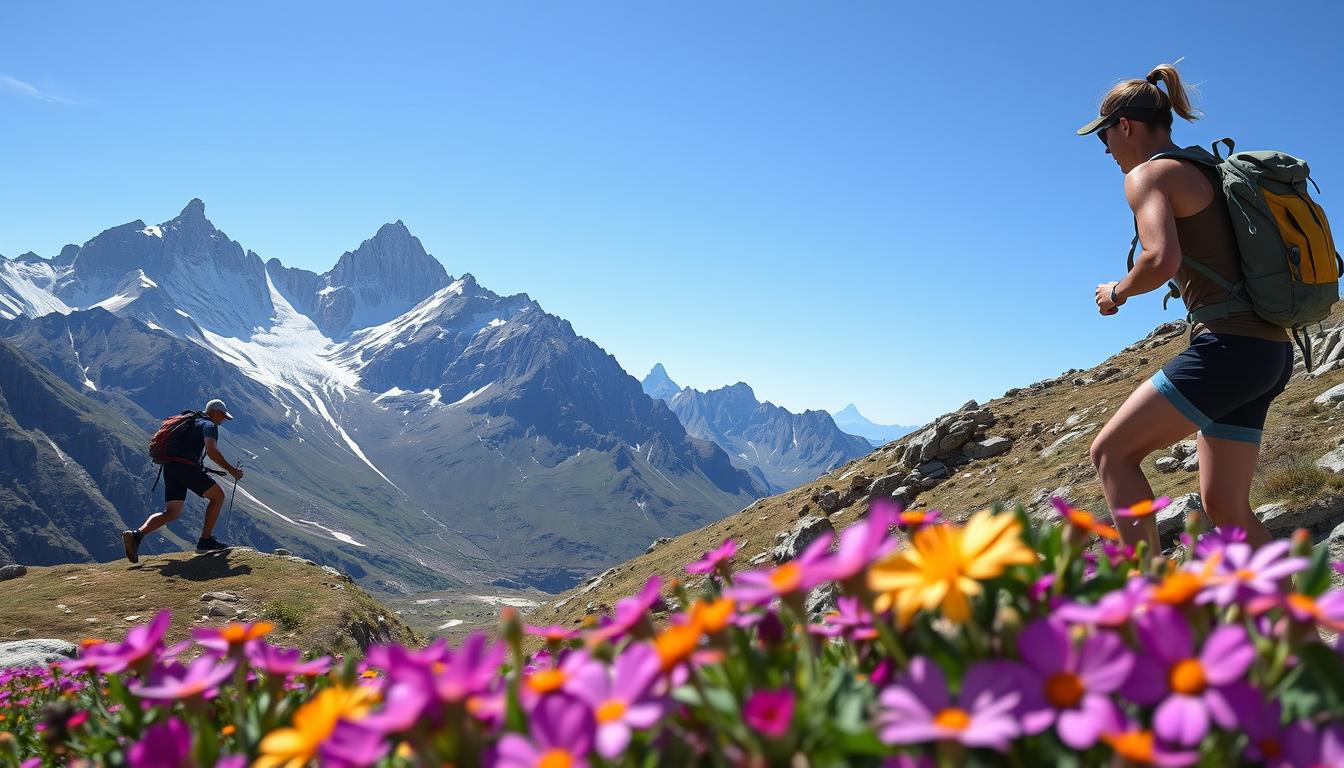Preparing for high altitude adventures involves thorough planning to handle the unique challenges posed by reduced oxygen levels. This preparation can’t be overstated, as hiking or trekking at higher elevations demands a level of fitness and acclimatization that many aren’t accustomed to at sea level.
High altitude is defined as any elevation above 2,500m (8,200 feet) above sea level. Symptoms of altitude sickness can start appearing at elevations as low as 2,000m (6,560 feet), making high altitude preparation essential. To boost your endurance and mitigate the risks associated with altitude sickness, such as headache, dizziness, and shortness of breath, a focused and gradual training regimen is crucial.
Training should incorporate activities that enhance both cardiovascular capacity and muscular endurance. Building this endurance means engaging in prolonged hours of physical activity, mimicking the actual stresses you’ll encounter while trekking high altitudes. Tailoring your workouts to reflect the specific conditions of the target altitude—such as the steepness and type of terrain—will ensure you’re well-prepared.
Moreover, training should focus on hours spent on activities rather than merely covering distances. The thin air at high elevations significantly decreases lung capacity and overall oxygen availability, so increasing your aerobic base is vital. By focusing on endurance training for high altitude, you strengthen your body’s ability to use oxygen more efficiently, thereby reducing the risk of altitude sickness.
Additionally, physiological effects of altitude are quite telling. For instance, at 3,658m (12,000 feet), the capacity of the body to acclimatize significantly drops, thus raising the chances of experiencing altitude sickness. When you reach heights of 5,500m (18,000 feet), problems like high altitude pulmonary edema (HAPE) and high altitude cerebral edema (HACE) become common due to minimal oxygen levels.
Mountaineers who spend five or more days above 3,000m (9,840 feet) before ascending to 4,500m (14,760 feet) have fewer cases of acute mountain sickness, showcasing the benefits of altitude acclimatization. Genetically, individuals from high-altitude regions have adapted to handle such environments better. However, those who are new to high altitude must follow a structured approach to prepare.
Thus, it’s evident that high altitude training encompasses more than just physical activity. It requires understanding how your body reacts to lower oxygen levels, how well you hydrate, and how you can gradually expose yourself to higher elevations. This holistic strategy not only builds your physical endurance but ensures a safer and more enjoyable high-altitude adventure.
Understanding High Altitude Challenges
When embarking on a high altitude journey, it’s crucial to comprehend the unique challenges posed by such elevations. From understanding the high altitude definition to recognizing the physiological changes your body undergoes, preparation is key to safe and enjoyable experiences at high altitudes.
What is High Altitude?
High altitude is characterized by elevations typically above 2,500 meters (8,202 feet), where the air’s oxygen content decreases significantly. Regions are divided into various categories:
- Low Altitude: Below 2,000 meters (6,562 feet)
- Moderate Altitude: Between 2,000 and 3,500 meters (6,562 – 11,483 feet)
- High Altitude: Between 3,500 and 5,500 meters (11,483 – 18,044 feet)
- Very High Altitude: Between 5,500 and 7,500 meters (18,044 – 24,606 feet)
- Extreme Altitude: Above 7,500 meters (24,606 feet)
Notable examples include La Paz, Bolivia, at roughly 3,650 meters (11,975 feet) and the Andes, with numerous peaks exceeding 6,000 meters (19,685 feet). Travelers frequent high-elevation destinations like Colorado’s ski resorts (≈2,440–3,050 meters) and Mount Kilimanjaro, Tanzania (≈5,900 meters).
Physiological Effects on the Body
High-altitude environments impact the human body in various ways. With reduced oxygen levels, your body must undergo oxygen adaptation to maintain normal function. For instance, at around 3,050 meters (10,000 feet), the inspired partial pressure of oxygen drops to 69% of that at sea level, resulting in arterial oxygen saturation falling to 88%-91%.
Common physiological responses include:
- Increased heart rate and breathing rate
- Shortness of breath, fatigue, and dizziness
- Possible development of altitude sickness
Acute Mountain Sickness (AMS) commonly occurs at elevations above 2,500 meters. More severe conditions like High-Altitude Pulmonary Edema (HAPE) and High-Altitude Cerebral Edema (HACE) can develop, requiring immediate medical intervention.
Proper oxygen adaptation and understanding these physiological effects are essential for safe acclimatization strategies. By acclimatizing over a few days and following a structured ascent plan, you increase your chances of enjoying your high-altitude adventure safely.
Physical Conditioning for High Altitude
Preparing your body for the rigors of high-altitude environments requires a well-rounded approach to physical conditioning. The three primary components of such an approach involve enhancing cardiovascular endurance, building muscle strength, and improving flexibility and balance. Each of these elements plays a crucial role in ensuring you can handle the various challenges that high-altitude trekking or climbing presents.
Cardiovascular Endurance
Developing cardiovascular endurance is essential for high-altitude activities where oxygen levels are lower. Engaging in cardio exercises for endurance, such as running, cycling, or swimming, can significantly improve the efficiency of your heart and lungs, thereby enhancing your oxygenation capacity. High-altitude experts often recommend interval training, which involves short bursts of intense exercise followed by periods of rest. This technique promotes efficient oxygen utilization, which is critical as you ascend to higher elevations where PaO2 falls below 65 mmHg.

Strength Training
Strength exercises for climbers are pivotal in fortifying the muscles that will be heavily utilized during climbs and treks. Focus on exercises that target your legs, such as squats, lunges, and deadlifts, as strong legs are invaluable for tackling steep inclines and maintaining stability on uneven terrain. Effective strength training can also include core exercises to enhance balance and stability, which is paramount in high-altitude conditions where simple tasks can become physically demanding.
Flexibility and Balance
Incorporating flexibility training into your routine helps prevent injuries and improves your overall physical resilience. Practices like yoga and Pilates not only enhance flexibility but also promote balance and coordination. Flexibility training ensures that your muscles remain supple and capable of handling the varied movements required in high-altitude activities. Enhanced balance reduces the risk of falls and injuries, which are more likely in the challenging, uneven landscapes encountered at high altitudes, where simple activities can exert immense physical stress.
Acclimatization Strategies
Successfully acclimatizing to high altitudes involves a variety of evidence-backed strategies. By understanding and applying these methods, you can significantly reduce the risk of altitude sickness and ensure a safer and more enjoyable ascent.
Gradual Altitude Exposure
A critical component in acclimatization is gradual altitude exposure. At elevations over 10,000 feet (3,048 meters), approximately 75% of individuals will experience symptoms of Acute Mountain Sickness (AMS). The barometric pressure at 12,000 feet (3,658 meters) drops to around 483 mmHg, reducing the oxygen molecules per breath by roughly 40% compared to sea level. To combat these effects, acclimatization generally takes 1-3 days at a specific altitude. It’s recommended to increase your elevation by no more than 1,000 feet (305 meters) per day. For every 3,000 feet (915 meters) gained, a rest day should be incorporated.
Hydration is vital. Maintaining a fluid intake of at least 3-4 quarts per day helps your body adjust better. Keeping your diet rich in carbohydrates—over 70% of your daily caloric intake—is also recommended.
The “Climb High, Sleep Low” Strategy
Another effective method is adopting the “climb high, sleep low” method. This strategy entails ascending to higher altitudes during the day but descending to sleep at a lower altitude. Such a regimen allows your body to better adjust to fluctuating oxygen levels. This technique is particularly recommended for challenging treks such as Mt. Kilimanjaro.
To illustrate, when aiming to summit elevations ranging between 9,900 to 12,510 feet, such as those on Aspen’s ski slopes, it’s advisable to avoid immediately sleeping at altitudes above 9,000 feet (2,750 meters). Instead, abide by a daily sleeping elevation gain of no more than 1,600 feet (500 meters) beyond 9,000 feet. Planning an extra day of acclimation for every 3,300 feet (1,000 meters) gained also facilitates better adaptation.
| Elevation | Barometric Pressure (mmHg) | Oxygen Molecules Per Breath | Total Recommended Fluid Intake |
|---|---|---|---|
| 10,000 feet (3,048 meters) | 664 mmHg | About 60% | 3-4 quarts/day |
| 12,000 feet (3,658 meters) | 483 mmHg | About 40% | 3-4 quarts/day |
Utilizing these acclimatization tips, such as gradual altitude exposure and the climb high sleep low method, can vastly improve your adaptation to high altitudes and help mitigate the risks associated with rapid ascent.
How to Prepare for High Altitude
Preparing for high altitude trekking necessitates a strategic approach, combining physical conditioning and simulated altitude acclimatization. By following structured pre-trip training plans and utilizing altitude simulation tools, you can effectively minimize the physiological challenges posed by high altitudes.
Pre-Trip Training Plans
To maximize your body’s ability to thrive in high-altitude environments, it’s essential to start your pre-trip training plans well in advance. Focus on exercises that enhance cardiovascular endurance, strength, and flexibility. Incorporate activities like running, hiking, or cycling to bolster your stamina. Consistent training should begin at least 3-6 months before your trek.
According to the CDC, the time required for acclimatization varies based on the target altitude: approximately 3 weeks for 6,000 feet, 4 weeks for 8,000 feet, 5 weeks for 10,000 feet, and up to 7 weeks for 14,000 feet. Aspen Hospital suggests that visitors spend a night in Denver before heading to higher altitudes like Aspen at 8,000 feet.
Using Altitude Simulation Tools
Altitude simulation workouts are an effective method to pre-acclimatize before your trek. Utilize tools such as hypoxic tents, masks, or specialized facilities like Traverse Fitness in Denver, which offers workouts in simulated low-oxygen settings, adjustable from sea level to 18,000 feet. Research indicates that sleeping in a mildly hypoxic state at home can help mitigate altitude sickness symptoms.

Spending a single day at elevation can significantly reduce the likelihood of sudden cardiac death by six times, as noted by Dr. Robert Shapiro. Additionally, the general rule of thumb for acclimatization is not to sleep higher than 1,600 feet per day to prevent altitude illness, which underscores the importance of gradual altitude exposure in your pre-trip plans.
| Target Elevation | Required Acclimatization Time | Recommended Strategy |
|---|---|---|
| Up to 6,000 feet | 3 weeks | Gradual increase in training intensity; spend nights at moderate elevations |
| Up to 8,000 feet | 4 weeks | Incorporate altitude simulation workouts; overnight in Denver suggested |
| Up to 10,000 feet | 5 weeks | Regular exposure to hypoxic conditions; maintain pre-trip training plans |
| Up to 14,000 feet | 7 weeks | Intensive conditioning; increase altitude gradually during training hikes |
By adhering to these detailed plans and utilizing altitude simulation tools, you can better prepare for high altitude treks, ensuring a safer and more enjoyable experience.
Hydration and Nutrition for High Altitude
When journeying to high altitudes, it’s crucial to implement proper hydration strategies and focus on nutrition for endurance. At higher elevations, your body not only dehydrates quicker but also requires more energy due to increased metabolic demands.
Your energy expenditure at extreme altitudes can range from 3250 to 4636 Kcal per day, with higher altitudes such as the Himalayas requiring around 3274 to 5394 Kcal per day depending on activity levels. This increase is driven by the necessity for hypoxic hyperventilation, thermoregulation, and sympathetic activation.
To support these energy needs, researchers recommend that at least 60% of your dietary intake come from carbohydrates. These nutrients are essential for maintaining energy levels and sustaining physical performance under such strenuous conditions. Eating about 20-30 grams of protein after exercise is also advised to aid in muscle repair and recovery.
Staying hydrated is equally important. Given that high altitudes lead to greater respiratory and urinary water losses, consuming around 3-5 liters (13-21 eight-ounce cups) of water daily can help prevent dehydration and its associated risks, like altitude sickness. Ample hydration strategies include drinking regularly and not relying solely on thirst cues.
Electrolytes and supplements can play a vital role in maintaining energy levels and overall health. They help replenish the electrolytes lost through increased urine production and sweat. Adding these to your diet ensures that your body functions optimally, even in less oxygenated environments.
| Mountain Range | Altitude (m) | Energy Expenditure (Kcal/day) |
|---|---|---|
| Alps | 3422 | 5572.8 |
| Himalaya | 5900–8046 | 4636 |
| Himalaya | 8840 | 3250 – 5394 |
| Cascade Range | 2500–3100 | 4558 |
Implementing these hydration strategies, focusing on nutrition for endurance, and incorporating electrolytes and supplements into your routine will better prepare your body for the high-altitude challenges ahead. Drink adequately, eat a balanced diet rich in carbohydrates and proteins, and adjust your nutrient intake to meet the increased demands of high-altitude expeditions.
Mental Preparation for Altitude Challenges
Preparing mentally for high-altitude challenges is as crucial as physical training. Not only does it help in maintaining calm, but it also ensures efficient oxygen usage. You’ll find that mindfulness for trekkers, along with practicing breathing techniques for altitude, significantly enhances your experience at higher elevations.
Mindfulness and Breathing Techniques
Altitude sickness, also known as acute mountain sickness, often affects your psychological state. Practicing mindfulness for trekkers can help mitigate these effects by keeping you grounded and focused. Incorporate deep breathing techniques into your routine to optimize oxygen intake and reduce symptoms like headaches and fatigue. These techniques become especially crucial when ascending quickly, as abrupt changes in altitude can trigger altitude sickness more readily than gradual climbs.
Mental Resilience Training
Mental resilience training is essential for building the psychological stamina required to face high-altitude challenges. Remember, 80% of overcoming these challenges is mental preparation. Preparing through short, multi-day hikes can acclimate your mind and body gradually, making longer treks less daunting. Practical exercises, such as engaging in discussions about emotional and mental support with trekking partners, can also boost your resilience and adaptability. Additionally, understanding the importance of acclimatization strategies can prepare you for the physical and mental demands ahead.
By integrating mindfulness for trekkers, breathing techniques for altitude, and consistent mental resilience training, you will be well-equipped to handle the strenuous conditions of high-altitude trekking.
Conclusion
Successfully preparing for and mastering high altitude challenges involves several interrelated strategies. First and foremost, physical conditioning tailored to high-altitude environments is crucial. By focusing on cardiovascular endurance, strength training, and flexibility, you build the stamina and resilience needed to endure the demanding terrain and rarified air of higher elevations.
Incremental acclimatization strategies are also vital. Following the guidance of the Himalayan Rescue Association and the Wilderness Medical Society regarding gradual altitude exposure can significantly mitigate the risk of severe altitude illnesses. Aim to ascend no more than 300 meters a day above 3000 meters and incorporate regular rest days. Such measures, although they may still result in mild Acute Mountain Sickness (AMS) in a notable percentage of individuals, drastically lower the likelihood of progressing to more severe conditions like high-altitude cerebral edema (HACE) or high-altitude pulmonary edema (HAPE).
Hydration and nutrition are equally essential components of a successful high-altitude trek preparation. Ensuring you consume 2-3 liters of water daily and maintaining a balanced diet enriches your body’s ability to cope with the environmental stresses of high altitudes. Additionally, mental preparation through mindfulness and resilience training prepares you to tackle the psychological challenges that come with high altitude treks.
By integrating these methods—physical fitness, proper acclimatization, strategic hydration and nutrition, and mental fortitude—you set yourself up for a rewarding and enriching high-altitude adventure. Whether you’re planning to climb Mount Kilimanjaro or explore the towering Himalayas, mastering high altitude challenges will enhance both your safety and enjoyment, transforming your journey into an extraordinary achievement.

